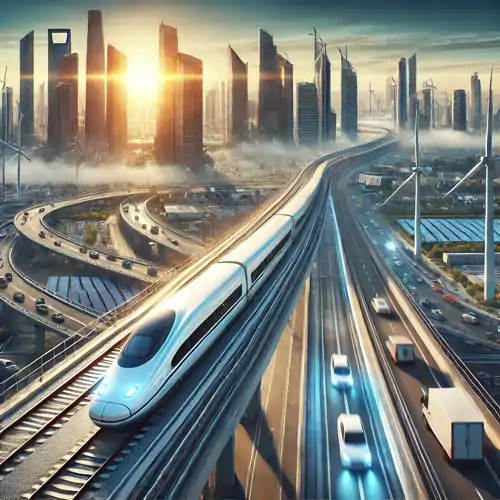In recent years, Spain has shown significant growth in investments in infrastructure, which allows not only to modernize the transport system, but also to solve the accumulated problems of mobility and ecology. Readers facing problems of travel delays, inefficiency of existing transport networks, and a shortage of modern facilities will find in this article an analysis of key projects and the prospects for their impact on improving the quality of life. The main keywords – infrastructure, Spain, investments, transport, railway – serve as a starting point for assessing the state and future development of the country.
1. Current state of transport infrastructure in Spain
Spain has long been known for its high level of transport infrastructure development. However, the accumulated investment deficit and outdated elements of the system have become pain points for passengers and carriers. The Ministry of Transport and Sustainable Mobility, headed by Minister Oscar Puente, is actively working to address these problems. In 2024, the volume of investments in transport infrastructure reached record levels, which indicates the strategic priority of the sector's development.
The key areas are the modernization of railway communication, the development of suburban and intercity lines, and the improvement of the road network. Thus, investments in the railway sector in 2024 amounted to 5.629 billion euros – 2.5 times more than in 2017. In addition, the traditional network received a significant boost, thanks to investments of 2.33 billion euros in maintenance and modernization projects.
2. Railway projects and their impact on mobility
The railway remains the main object of investment, since not only freight transportation, but also the daily mobility of citizens depends on its efficiency. High-speed trains, such as the AVE (Alta Velocidad Española – Spanish High Speed), can significantly reduce travel time between major cities. One of the important projects is the construction of a new high-speed railway station under the Atocha terminal in Madrid, which will become a hub for transfers and integration of various directions.
Within the framework of the Madrid Nuevo Norte project, measures are being implemented to restore and modernize the railway infrastructure, which will allow to combine different transport systems: high-speed, suburban, intercity and regional lines. This, in turn, helps to reduce transfer waiting times, increase passenger comfort and improve the overall network capacity.
An additional plus is the integration with other modes of transport – metro and buses. Thanks to an integrated approach, a unified system is being created that can provide access to public transport within 10-15 minutes walking distance from residential and business districts. This solution is especially relevant for large metropolitan areas, where the issue of integrating various types of transport has long been acute.
3. Road construction and modernization
Along with the development of the railway network, Spain is focusing on the modernization of the state road network. Since 2018, the funds allocated for the maintenance and improvement of road infrastructure have significantly increased. In particular, annual expenditures on environmental protection and road maintenance have reached 1.5 billion euros – twice as much as in the previous period.
Improving the road surface and introducing new sections contribute not only to increasing road safety, but also to reducing maintenance costs. The practice of toll exemption on some sections of the road network helps to speed up the work, which is especially important in conditions of high traffic flow.
4. Energy efficiency and sustainable development
One of the main tasks of the current government is the decarbonization (reduction of carbon dioxide emissions) of the transport system. Spain is demonstrating leadership in the field of renewable energy sources, combining investments in solar and wind energy with large-scale infrastructure projects. At the moment, the country has 29.5 GW of installed solar energy, and projects under construction and early development are showing high growth rates.
To achieve sustainable development goals, the government is actively working to eliminate bottlenecks in the permitting process and stimulate the development of small-scale solar installations. Combining energy initiatives with the modernization of transport infrastructure allows to ensure stable economic development, as well as to improve the environmental situation in cities.
An important step on this path is the implementation of measures to integrate renewable sources into the national energy supply system. This allows to reduce dependence on fossil fuels and create conditions for sustainable economic growth.
5. Large infrastructure megaprojects
In addition to comprehensive programs for the modernization of the railway and road sectors, Spain is implementing large-scale infrastructure megaprojects that can transform the country's image at the national level. Other significant projects include the Chamartín-Clara Campoamor Station Reconstruction in Madrid, the creation of new metro lines and the development of suburban services. These initiatives are aimed at eliminating gaps between districts, improving the city's connectivity and increasing the attractiveness of public transport.
This project involves the construction of bridge structures, tunnels and intermediate stations, which will reduce travel time and integrate regional transport hubs.
In addition to the transport sector, infrastructure projects related to energy security are being implemented. Thus, the Castor project (underground gas storage) is designed to increase the country's energy security by creating strategic gas reserves. Despite the technical and environmental difficulties, this project demonstrates the importance of an integrated approach to infrastructure development.
No less ambitious is the Elysium City project, aimed at creating a world-class entertainment and tourist complex. Its implementation involves the creation of theme parks, modern stadiums and urban regeneration facilities, which in the future can contribute to the revival of the regional economy.
6. Addressing pain points and development prospects
The main pain points faced by users of transport infrastructure are long transfer waiting times, inconvenient location of public transport stops, outdated facilities and lack of investment. The measures taken to modernize railway and road networks, as well as the integration of various modes of transport, contribute to addressing these problems.
Reducing travel time, increasing the reliability of transport networks and improving conditions for passengers are the main advantages of the implemented projects. Measures to decarbonize the transport system and develop renewable energy solve environmental problems, reducing CO2 (carbon dioxide) emissions and contributing to improving air quality.
The government's comprehensive approach, combining investments in infrastructure, the development of innovative technologies and support for sustainable projects, guarantees not only the recovery of the accumulated deficit, but also the creation of conditions for further economic growth. Thus, modern infrastructure projects make it possible to solve mobility problems, create comfortable conditions for passengers and ensure the country's sustainable development.
Conclusion
The analysis of the implemented infrastructure projects shows that Spain is on the way to transforming the transport system and sustainable development. The implementation of large-scale investments in railways, roads, energy and urban infrastructure is aimed at eliminating pain points such as traffic delays, low capacity and environmental problems. Combining modernization with innovative solutions improves the quality of life of citizens and stimulates economic growth.
Despite the existing difficulties, an integrated approach to solving infrastructure problems demonstrates high efficiency. Future projects, such as the high-speed rail line, new railway hubs and energy initiatives, are key factors contributing to improving transport connectivity and sustainable development of Spain.








